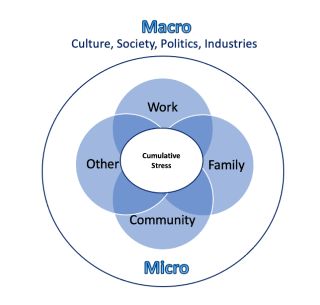Burnout
5 Misconceptions About Burnout
Everyone talks about burnout, but considerable misinformation exists.
Posted February 9, 2024 Reviewed by Ray Parker
Key points
- Burnout is multifaceted and requires a nuanced understanding.
- Burnout is an unmitigated chronic stress-induced disorder.
- Burnout is manageable but requires effort and control, focusing on what you can control.
Burnout is everywhere. You can't listen to the news or read any journal or paper without hearing about burnout. And it has become the word of the day at many places of employment. But burnout is tremendously misunderstood and often depicted quite inaccurately. This prevents many people from effectively addressing their real or perceived burnout.
To address burnout symptomology, it is important to understand some of these inaccurate misconceptions that are too frequently reported and not allow them to be barriers to improvement.
1. Burnout only happens at work
This is one of the most common misconceptions I hear. In fact, many definitions even state that burnout only happens at work. The truth is that burnout is caused by chronic stress, which happens in all areas of life, both at the macro and micro levels. Equally importantly, its negative effects are cumulative in nature (see Figure 1). Parents can be burned out with their kids; spouses can be burned out with their significant other, and people can be burned out with their workouts, diet, church, political affiliations, hobbies, and just about anything else.

Work typically consumes the most hours in the day and often leads to stressors that can cause burnout, but it is important to understand that burnout is ever-present in life. Dealing with burnout requires considering the whole spectrum of situations where stress can surface and how cross-situational interactions occur.
2. Burnout can be fixed with quick remedies
Burned results from stressors that are chronic in nature and unmitigated. In other words, burnout is a chronic stress-induced condition. Quick fixes will not alleviate the underlying chronic stress. The underlying causal stressors must be effectively addressed.
Telling yourself to take a few breaths may help with the stress that is acute in nature (right before you give a presentation.) but will not help with chronic stressful situations that last weeks, months, and years and are multi-factorial. Burnout requires techniques that are more comprehensive and fundamental in nature.
3. Fixing burnout just requires willpower
Suck it up. Quit whining. Work harder. Don't be a baby.
These comments can be directed at a person who reports being burned out. Unfortunately, none of these statements work in helping a person who is truly burned out to address it. You can't force yourself through burnout and expect it to go away.
Again, we must understand that burnout is a chronic stress-induced condition—grounded in evolutionary principles. Our brains still treat all stressors as if they are truly emergent, causing harm or death. Our stress-reactive systems are evolutionarily wired to flood your body with neurotransmitters, hormones, and immune system molecules that help to keep you safe.
This response is critical in life-and-death acute scenarios; however, in stressful situations that are chronic, they cause more harm than good and lead to many mental health and physical conditions.
Given that with burnout, you are facing psychophysiological electrochemical reactions, you cannot just "suck it up." You must employ much deeper, meaningful tools to relieve stress-induced burnout.
4. Everyone is burned out
Ultimately, as psychologists and medical providers, we want to help people. But unfortunately, we often are too ready to label someone with a diagnosis. It is well reported that diagnosing someone with a condition or disease state often causes the person to develop the particular condition further or leads to detrimental stigma and shame (Garand et al., 2009).
There is significant variation in the incidence and prevalence of burnout, but overall, 28% of the general population reports burnout (Brassey et al., 2022; Fred & Scheid, 2018).
Burnout, like many psychological conditions, falls along a normally distributed continuum: a bell-shaped curve. Additionally, we all have natural highs and lows that cycle over time and demonstrate large variations. You cannot be expected always to be 100% energized at work, with your kids, in your marriage, at school, with your workouts, etc.
Understanding that going through these cycles is normal can help you balance your life more effectively and look for strategies to re-energize in areas that are a bit down naturally. But by labeling yourself burned out, you can go too far and take measures that are more than warranted or necessary—often making the situation worse. Of course, if you are truly burned out, use well-researched techniques to find relief.
5. Burnout cannot be improved
As discussed, burnout cannot be cured with quick fixes. It requires a lot more work to mitigate effectively. Most importantly, take action with what you have control over. Foster your internal locus of control. Simply thinking about what you can control and developing a plan to do so can, in and of itself, be helpful.
Then, taking steps to reduce the underlying causal factors and stressors leading to stress-induced burnout can go a long way to helping you find relief. Sometimes, the factors causing your burnout cannot be easily controlled (a negative boss). However, by defining actions to control what you can control, you can still greatly reduce your stress, making your burnout much less impactful.
In Summary
Burnout results from evolutionary-driven chronic stress that has not been managed. It occurs in all areas of your life and exhibits a strong cumulative effect. By understanding what burnout is and what it is not, you can be much more effective in treating your unique situation.
References
Garand, L., Lingler, J.H., Conner, K.O., & Dew, M.A. (2009). Diagnostic labels, stigma, and participation in research related to dementia and mild cognitive impairment. Research in Gerontological Nursing, 2(2), 112-21. doi: 10.3928/19404921-20090401-04.
Brassey, J., et al. (2022). Addressing employee burnout: Are you solving the right problem? McKinsey Health Institute. https://www.mckinsey.com/mhi/our-insights/addressing-employee-burnout-are-you-solving-the-right-problem#/
Fred, H.L. & Scheid, M.S. (2018). Physician burnout: Causes, consequences, and cures. Texas Heart Institute Journal, 45(4):198-202. doi: 10.14503/THIJ-18-6842. PMID: 30374225; PMCID: PMC6183652.
See my posts 10 Ways to Beat Burnout and 5 More Ways to Beat Burnout.




